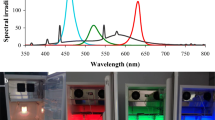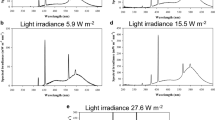Abstract
Spores, harvested from 8 da old colonies ofColletotrichum dematium varcircinans (Berk.) v. Arx, were placed on slides under shimmed coverslips and subjected to 10 min irradiation with wavelengths of light ranging from 400 to 750 nm. Controls consisted of spores exposed to 10 min of fluorescent or tungsten light, or to continuous dark. Germination, and production of sessile and non-sessile appressoria, and germ-tubes was monitored. In addition position of germ-tubes on spores was noted and germination types were classified by numbers of germ-tubes and sessile and non-sessile appressoria produced. When compared to dark controls certain wavelengths, 400, 450, 600 and 650 nm, appeared to be inhibitory to germination and post-germination development, while others, 500, 550 and 750 nm, appeared to be stimulatory. Spores irradiated with some of the wavelengths (550, 700, 750 nm) that affected other responses produced the smallest percentage of sessile appressoria (approx. 10%). Placement of germ-tubes was not affected by treatment. More germ-tubes were produced from spore bottoms (53%) than tops (32%), and tips (15%). The fewest number of germ-tubes was produced from spore centers and from one tip. Thirteen germination types were noted. About 53% of spores germinated with one germ-tube, one non-sessile appressoria, and no sessile appressoria. The remaining 47% were distributed throughout the remaining 12 types, and ranged from 21% to less than 1% of the total. Treatments did not affect this distribution.
Similar content being viewed by others
References
Calpouzos, L. & Chang, H., 1971. Fungus spore germination inhibited by blue and far-red radiation. Plant Physiol. 47: 729–730.
Carlile, M. J., 1970. The photoresponses of fungi. In: Photobiology of Microorganisms, pp. 309–344. Wiley-Interscience, New York.
Chang, H., Calpouzos, L. & Wilcoxson, R. D., 1973. Germination of hydrated uredospores of Puccinia recondita inhibited by light. Can. J. Bot. 51: 2459–2462.
Cochrane, V. W., 1958. Physiology of Fungi. John Wiley & Sons, New York. 524 pgs.
Emmett, R. W. & Parberry, D. G., 1975. Appressoria. Ann Rev. Phytopathol. 13: 147–167.
Hoffman, G. (ed.), 1977. Iscotables. A handbook of data for biological and physical scientists. 7th ed. Instrumentation Specialties Co., Lincoln, Nebraska.
Ishida, N. & Akai, S., 1969. Relation of temperature and germination of conidia and appressorium formation in Colletotrichum lagenarium. Mycologia 61: 382–386.
Khan, M., 1977. Light stimulation of fungus spore germination. Z. Pflanzenphysiol. 81: 374–376.
Kunoh, H., Takamatsu, S. & Ishizaki, H., 1978. Cytological studies of early stages of powdery mildew in barley and wheat. III. Distributions of residual calcium and silicon in germinated conidia of Erysiphe graminis hordei.
Leach, C. M., 1971. A practical guide to the effects of visible and ultraviolet radiation on fungi. In: C. Booth (ed.). Methods in Microbiology, Vol. IV, pp. 604–664. Academic Press, New York.
Leach, C. M., 1972. An action spectrum for light-induced sexual reproduction in ascomycete fungus Leptosphaerulina trifolii. Mycologia 64: 475–490.
Leath, K. T., 1971. Quality of light required for sporulation by Leptosphaerulina. Phytopathology 61: 70–72.
Macko, V., Staples, R. C., Yaniv, Z. & Granados, R. R., 1976. Self inhibitors of fungal spore germination. In: The fungal spore. Form and function. John Wiley & Sons, New York.
Mohr, H., 1961. Wirkungen Kurzwelligen Lichtes. In: Handb. Pflanzenphysiol., Vol. 16, pp. 439–531. Springer, Berlin, Gottingen, Heidelberg.
Murphy, J. A., Thompson, M. R. & Pappelis, A. J., 1976. Ultrastructure and elemental composition of dormant and germinating Diplodia maydis spores. J. Bacterial. 127: 1465–1471.
Osman, M. & Valadon, L. R. G., 1979. Effect of light quality on growth and sporulation in Verticillium agaricinum. Trans. Br. Mycol. Sco. 72: 145–146.
Parberry, D. G. & Blakeman, J. P., 1978. Effect of substances associated with leaf surfaces on appressorium formation by Colletotrichum acutatum. Trans. Br. Mycol. Soc. 70: 7–19.
Russo, V., Anderson, C. & Pappelis, A. J., 1979. Effect on germination and post-germination development of Colletotrichum dematium var circinans due to light and dark incubation and coverslip placement. Mycopathologia 67: 165–168.
Schanz, K., 1968. Die steuerung der Bandsporenkeimung und sporidienbildung bei Telletia caries (DC) Tul. durch licht. Archiv. für Mikrobiol. 60: 111–123.
Smith, E. C., 1936. The effects of radiation on fungi. In: B. M. Duggar (ed.), Biological effects of radiation, Vol. II, pp. 889–918. McGraw-Hill, New York.
Tan, K. K., 1974. Blue-light inhibition of sporulation in Botrytis cinerea. J. Gen Microbiol. 82: 191–200.
Tan, K. K., 1974. Red-far-red reversible photoreaction in the recovery from blue-light inhibition of sporulation in Botrytis cinerea. J. Gen. Microbiol. 82: 201–202.
Tan, K. K. & Epton, H. A. S., 1974. Further studies on light and sporulation in Botrytis cinerea. Trans. Br. Mycol. Soc. 62: 105–112.
Thomas, C. E., 1964. The effect of media and light quality on growth and sporulation of Leptosphaerulina trifolii and L. australis foliar pathogens of white clover. MS thesis. Clemson University, Clemson, South Carolina.
Thomas, C. E. & Halpin, J. E., 1964. Effect of predisposition temperature and the subsequent exposure to various light qualities on the growth and sporulation of Leptosphaerulina briosiana. Phytopathology 54: 910 (Abstr.).
Thomas, C. E., 1966. Studies on the effects of light and other factors on the growth and sporulation of selected Leptosporulina species. Ph.D. thesis. Clemson University, Clemson, South Carolina. (Diss. Abstr. 27B: 1364).
Yamamura, S., Kumagai, T. & Oda, Y., 1978. Mycochrome system and conidial development in a non-photoinduced isolate of Helminthosporium oryzae. Can. J. Bot. 56: 206–208.
Author information
Authors and Affiliations
Rights and permissions
About this article
Cite this article
Russo, V.M., Pappelis, A.J. Effect of prism generated discreet wavelengths of light on germination and post-germination development of Colletotrichum dematium var circinans (Berk.) v. Arx. Mycopathologia 73, 129–134 (1981). https://doi.org/10.1007/BF00575083
Issue Date:
DOI: https://doi.org/10.1007/BF00575083




